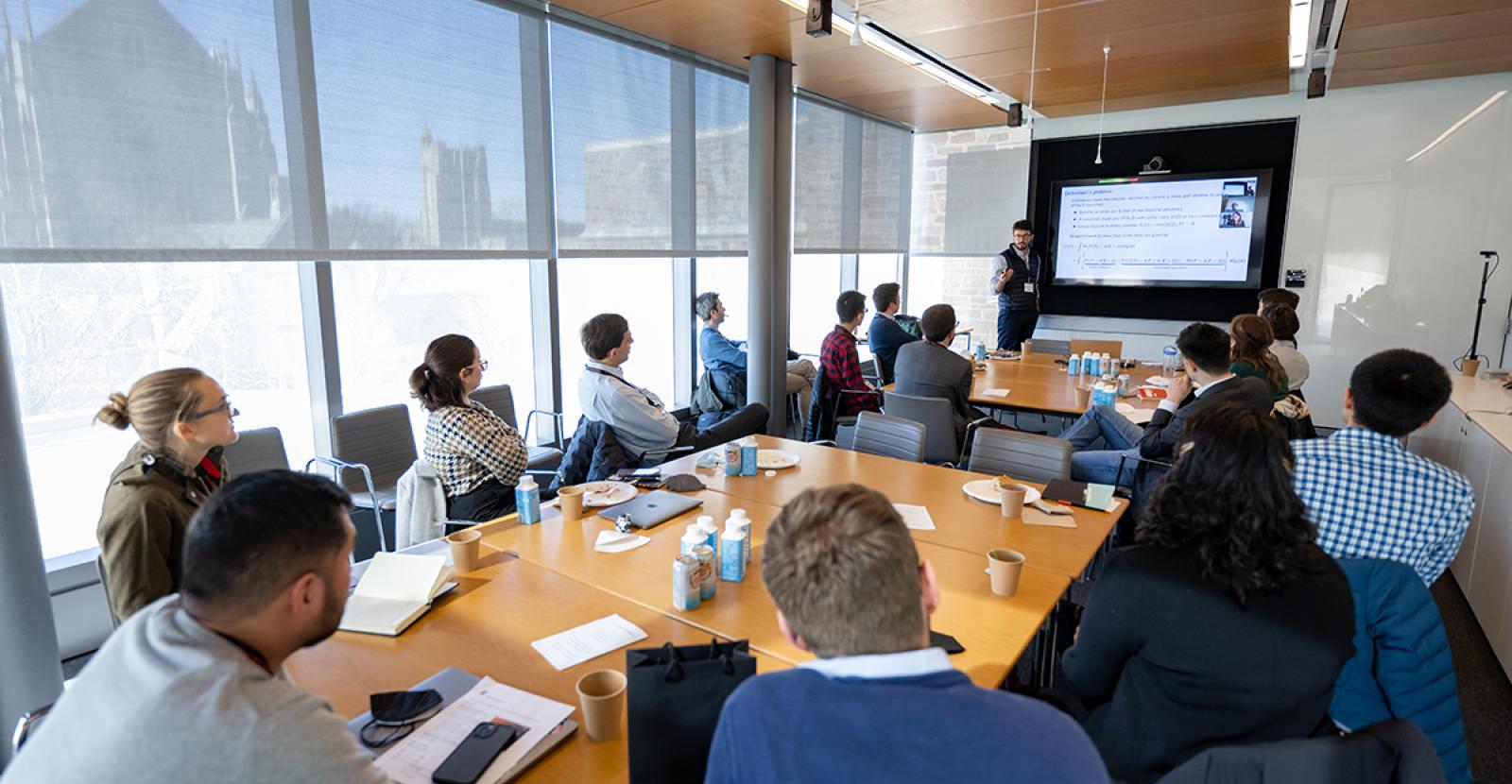| Time | Event | Details |
|---|---|---|
| 08:40am - 09:20am | Breakfast |
|
| 09:20am - 10:00am | Managers and the Cultural Transmission of Gender Norms
Gender
|
Authors: Virginia Minni, Kieu-Trang Nguyen, and Heather Sarsons Discussant: Jaime Arellano-Bover |
| 10:00am - 10:40am | One Cohort at a Time: A New Perspective on the Declining Gender Pay Gap
Gender
|
Authors: Jaime Arellano-Bover, Nicola Bianchi, Salvatore Lattanzio, and Matteo Paradisi Discussant: Virginia Minni |
| 10:40am - 11:00am | BREAK |
|
| 11:00am - 11:40am | Location Effects or Sorting? Evidence from Firm Relocation
Firms and Wages
|
Authors: Pauline Carry, Benny Kleinman, and Elio Nimier-David Discussant: Michael Amior |
| 11:40am - 12:20pm | Internal Pay Equity and the Quantity-Quality Trade-Off in Hiring
Firms and Wages
|
Authors: Michael Amior and Shmuel San Discussant: Elio Nimier-David |
| 12:20pm - 12:00pm | Lunch |
|
| 01:20pm - 02:00pm | Mobile Crisis Response Teams Support Better Policing: Evidence from CAHOOTS
Law and Economics
|
Authors: Jonathan Davis, Samuel Norris, Jadon Schmitt, Yotam Shem-Tov, and Chelsea Strickland Discussant: Charlie Rafkin |
| 02:00pm - 02:40pm | Legal Assistance for Evictions: Impacts, Mechanisms, and Demand
Law and Economics
|
Authors: Aviv Caspi and Charlie Rafkin Discussant: Yotam Shem-Tov |
| 02:40pm - 03:00pm | BREAK |
|
| 03:00pm - 03:40pm | Should I Stay, or Should I Go? Strategic Responses to Improve College Admission Chances
Education
|
Authors: Carolina Concha-Arriagada Discussant: Angela Crema |
| 03:40pm - 04:20pm | School Competition, Classroom Formation, and Academic Quality
Education
|
Authors: Angela Crema Discussant: Carolina Concha-Arriagada |
| 04:20pm - 04:35pm | BREAK |
|
| 04:35pm - 05:15pm | The Class Gap in Career Progression: Evidence from US Academia
Inequality
|
Authors: Anna Stansbury and Kyra Rodriguez Discussant: Benjamin Goldman |
| 05:15pm - 05:55pm | Who Marries Whom? The Role of Segregation by Race and Class
Inequality
|
Authors: Benjamin Goldman, Jamie Gracie, and Sonya R. Porter Discussant: Anna Stansbury |
There are no agendas for this day.
| Time | Event | Details |
|---|---|---|
| 08:00am - 08:40am | Breakfast |
|
| 08:40am - 09:20am | Do Words Matter? The Value of Collective Bargaining Agreements
Compensation
|
Author: Benjamin W. Arold, Elliott Ash, W. Bentley MacLeod, and Suresh Naidu Discussant: Yiqun Chen |
| 09:20am - 10:00am | The Productivity of Professions: Evidence from the Emergency Department
Compensation
|
Author: David Chan and Yiqun Chen Discussant: Benjamin W. Arold |
| 10:00am - 10:20am | BREAK |
|
| 10:20am - 11:00am | Personal Connections and Hiring Decisions in the Public Sector
Developing Economies
|
Authors: Tatiana Mocanu and Eleonora Patacchini Discussant: Nicholas Swanson |
| 11:00am - 11:40am | Under-training by Employers in Informal Labor Markets: Evidence from Burundi
Developing Economies
|
Authors: Luisa Cefala, Pedro Naso, Michel Ndayikeza, and Nicholas Swanson Discussant: Tatiana Mocanu |
| 11:40am - 12:00am | BREAK |
|
| 12:00pm - 12:40pm | From Labor to Intermediates: Firm Growth, Input Substitution, and Monopsony
Labor Demand
|
Authors: Matthias Mertens and Benjamin Schoefer Discussant: Joonas Tuhkuri |
| 12:40pm - 01:20pm | Winners and Losers of Technology Grants: Evidence on Jobs and Skills
Labor Demand
|
Authors: Johannes Hirvonen, Aapo Stenhammar, and Joonas Tuhkuri Discussant: Matthias Mertens |
| 01:20pm - 02:20pm | Lunch |
March 27 at 9:20am
Managers and The Cultural Transmission of Gender Norms
Virginia Minni
University of Chicago Booth School of Business
Speaker Bio:
I am an Assistant Professor of Economics at the University of Chicago Booth School of Business. My research focuses on questions in labor, organizational, and development economics.
March 27 at 10:00am
One Cohort at a Time: A New Perspective on the Declining Gender Pay Gap
Jaime Arellano-Bover
Yale University
Abstract
This paper studies the interaction between the decrease in the gender pay gap and the stagnation in the careers of younger workers, analyzing data from the United States, Italy, Canada, and the United Kingdom. Our findings highlight the importance of labor-market entry to understand the shrinking of the gender pay gap. The entire decline in the aggregate pay gap originates from (i) newer worker cohorts who enter the labor market with smaller-than-average gender pay gaps and (ii) older worker cohorts who exit with higher-than-average gender pay gaps. Convergence at labor-market entry originates primarily from younger men’s positional losses in firms’ hierarchies and the overall pay distribution. We propose an explanation by which a larger supply of older workers can crowd out younger workers from a limited number of top-paying positions. These negative career spillovers disproportionately affect the career trajectories of younger men because they were more likely than younger women to hold higher-paying jobs at baseline. Consistent with this aging-driven crowd-out interpretation, younger men experience the largest positional losses within the hierarchies of firms that are more exposed to workforce aging. These findings hold after controlling for alternative explanations for the progressive closure of the gender pay gap at labor-market entry. Finally, we document that labor-market exit has been the sole contributor to the decline in the gender pay gap after the mid-1990s, indicating that without structural breaks, the closure of the gender pay gap is unlikely in the foreseeable future.
Speaker Bio:
I am a labor economist and applied microeconomist. My research interests include labor, migration, human capital, and firm dynamics.

March 27 at 11:00am
Location Effects or Sorting? Evidence from Firm Relocation
Elio Nimier-David
Cornell University
Abstract
Why are wages in Paris and San Francisco higher than in other cities? This paper leverages firm mobility to separate the role of "location effects" (stemming from infrastructure and agglomeration) from the spatial sorting of workers and firms. Using comprehensive French administrative records and U.S. commercial data, we show that about 4% of establishments relocate annually while largely maintaining their operational profiles. Combining firm and worker mobility, we decompose wage disparities across French commuting zones: location effects account for only 2–5% of the gap, with worker and firm heterogeneity explaining 30% and 20%, respectively, and their co-location the remaining half. Revisiting the local wage-density elasticity yields a significant coefficient of 0.008---two to three times lower than estimates not controlling for firm composition. Finally, our findings provide insights for local policies aimed at attracting high-paying firms.
Speaker Bio:
I am an Assistant Professor in the Department of Economics and the School of Industrial and Labor Relations at Cornell University.

March 27 at 11:40am
Internal Pay Equity and the Quantity-Quality Trade-Off in Hiring
Michael Amior
Hebrew University
Abstract
Firms face significant constraints in their ability to differentiate pay by worker productivity. We show how these internal equity constraints generate a quantity-quality trade-off in hiring: firms which offer higher wages attract higher skilled workers, but cannot profitably employ lower skilled workers. In equilibrium, this mechanism leads to workplace segregation and pay dispersion even among ex-ante identical firms. Unlike in a conventional monopsony model, firms use higher pay to improve hiring quality, even at the cost of lower quantity. Our framework provides a novel interpretation of the (empirically successful) log additive AKM wage model, and shows how log additivity can be reconciled with sorting of high-skilled workers to high-paying firms. It can also rationalize a hump-shaped relationship between firm size and firm pay - and, by implication, the small wage return to firm size. Finally, our model provides new insights into aggregate-level and regional changes in worker-firm sorting and earnings inequality, firms' location choices, and public-private sector wage differentials - which we explore empirically using Israeli administrative data.
Speaker Bio:
I am a Lecturer (Assistant Professor) in Economics at the Hebrew University of Jerusalem. I am also a Research Associate at the Centre for Economic Performance at LSE.
March 27 at 1:20pm
Mobile Crisis Response Teams Support Better Policing: Evidence from CAHOOTS
Yotam Shem-Tov
University of California, Los Angeles
Speaker Bio:
I am an Assistant Professor of Economics at the University of California, Los Angeles. I study topics in labor economics, criminal justice and crime, and applied econometrics.

March 27 at 2:00pm
Legal Assistance for Evictions: Impacts, Mechanisms, and Demand
Charlie Rafkin
UC Berkeley
Abstract
3.6 million eviction cases are filed annually, mostly against tenants without legal representation. We randomize provision of attorneys to tenants facing eviction in Memphis, Tennessee (N = 307 attorneys provided) to study the effects of representation as policymakers actively debate expanding guarantees of lawyers to include eviction. Despite landlord-friendly eviction law, providing an attorney reduces tenant eviction judgment rates within 180 days by 23 percentage points (37%). However, attorneys' effects persist only when they can connect tenants to other services. Once a concurrent emergency rental assistance program expires, effects on judgments at 180 days shrink by about 75% and are indistinguishable from zero. Incentivized surveys suggest tenants' demand for an attorney is double attorneys' price, and eight times attorneys' implied impacts on tenants' incomes via stopping evictions. This high willingness to pay does not appear to result from elicitation errors, misperceptions, or binding budget constraints. We contrast lawyers' Marginal Value of Public Funds from using elicited willingness to pay (MVPF = 2.7 without rental assistance, ignoring impacts on landlords or general equilibrium) versus a standard calibrated approach (MVPF = 0.3) and discuss implications for the evaluation of policies involving in-kind goods.
Speaker Bio:
I am a behavioral and public economist. In January 2026, I'll join the University of British Columbia as an Assistant Professor of Economics, following postdocs at Berkeley (Fall 2024–Summer 2025) and Stanford (Fall 2025).
March 27 at 3:00pm
Should I Stay or Should I Go? Strategic Responses to Improve College Admission Chances
Carolina Concha-Arriagada
Columbia University
Abstract
Policies aimed at increasing the number of students from underrepresented groups enrolled in college are common worldwide. Many of these policies can result in strategic responses by high school students. Yet, little is known about the extent to which these responses undo the effect of the policy. This paper shows that centralized college admission policies that rank students within their high school lead to strategic relocation of students, which undoes part of the effects of the policy. Relying on a policy change in Chile, I use detailed administrative data and a simple theoretical model to show that high school students react to these sorts of college admission policies by switching schools, undermining the policy effects. I find that the number of low-income students accepted to the top colleges increases by less than 1 percent under the current. policy, but if students had not switched high schools, that increase would be 5 percent, a reduction of 90 percent in the policy effectiveness. In addition, switchers target high schools with lower average GPAs, and they significantly increase their probability of attending selective colleges. I argue that relocation is an important pre-college response, which needs to be considered when designing policies using schools as target characteristics, as it can completely undermine said policies.
Speaker Bio:
I am an Assistant Professor of Economics and Education at Teachers College, Columbia University. Primary fields include, Applied Microeconomics, Economics of Education.

March 27 at 3:40pm
School Competition, Classroom Formation, and Academic Quality
Angela Crema
Broad Center – Yale SOM
Speaker Bio:
I am a Postdoctoral Associate at the Broad Center – Yale SOM. I completed my PhD at NYU in 2024. I am interested in racial inequality in education and labor markets. My work focuses on schools’ competitive incentives and their implications for student segregation.
March 27 at 4:35pm
The Class Gap in Career Progression: Evidence from US Academia
Anna Stansbury
MIT Sloan
Abstract
Unlike gender or race, class is rarely a focus of research or DEI efforts in elite US occupations. Should it be? In this paper, we document a large class gap in career progression in one labor market: US tenure-track academia. Using parental education to proxy for socioeconomic background, we compare career outcomes of people who got their PhDs in the same institution and field (excluding those with PhD parents). First-generation college graduates are 13% less likely to end up tenured at an R1, and are on average tenured at institutions ranked 9% lower, than their PhD classmates with a parent with a (non-PhD) graduate degree. We explore three mechanisms: (1) productivity, (2) preferences, and (3) discrimination. Research productivity can explain at most a third of the class gap, meaning first-gen college grads are “underplaced” at lower-ranked institutions than their research record would predict. Preferences explain almost none of the class gap. Discrimination likely explains the residual. Specifically, systemic or direct discrimination may arise from a lack of social and cultural capital. We find evidence consistent with this in analyses of coauthor networks and NSF awards. Finally, examining PhDs who work in
industry we find a class gap in pay and in managerial responsibilities which widens over the career. This establishes that a class gap in career progression exists in other US occupations beyond academia.
Speaker Bio:
I'm an Assistant Professor at MIT Sloan. Research interests in labor and macro economics. My work is particularly focused on issues to do with power and institutions in the labor market.

March 27 at 5:15pm
Who Marries Whom? The Role of Segregation by Race and Class
Benjamin Goldman
Cornell University
Abstract
Americans rarely marry outside their race or class group, a pattern with well-documented implications for inequality and intergenerational mobility. Limited exposure—or interactions with members of other groups—may partly explain these low intergroup marriage rates. We instrument for exposure using variation in childhood neighborhoods based on whether other race and class groups had more opposite-sex children of similar age. Exposure increases interclass (high- and low-parent-income) marriage but has no detectable effect on interracial (White and Black) marriage. A spatial marriage market model predicts that residential segregation—one of many forms of exposure—accounts for more than one third of marital sorting by class but less than 5% by race.
Speaker Bio:
I will be joining Cornell University in 2025 as an Assistant Professor in the Department of Economics and the Jeb E. Brooks School of Public Policy. Currently, I am a postdoc at Cornell University. My research focuses on labor and public economics, with an emphasis on race- and class-based economic disparities in the United States.
March 28 at 8:40am
Do Words Matter? The Value of Collective Bargaining Agreements
Benjamin Arold
University of Cambridge
Abstract
This paper proposes novel natural language methods to measure worker rights from collective bargaining agreements (CBAs) for use in empirical economic analysis. Applying unsupervised text-as-data algorithms to a new collection of 30,000 CBAs from Canada in the period 1986-2015, we parse legal obligations (e.g. “the employer shall provide...”) and legal rights (e.g. “workers shall receive...”) from the contract text. We validate that contract clauses provide worker rights, which include both amenities and control over the work environment. Companies that provide more worker rights score highly on a survey indicating pro-worker management practices. Using time-varying province-level variation in labor income tax rates, we find that higher taxes increase the share of worker-rights clauses while reducing pre-tax wages in unionized firms, consistent with a substitution effect away from taxed compensation (wages) toward untaxed amenities
worker rights). Further, an exogenous increase in the value of outside options (from a Bartik instrument for labor demand) increases the share of worker rights clauses in CBAs. Combining the regression estimates, we infer that a one-standard deviation increase in worker rights is valued at about 5.7% of wages.
Speaker Bio:
I am an Assistant Professor (promotion-track to Associate Professor) at the Faculty of Economics at the University of Cambridge. am an applied microeconomist interested in labor and education economics, public economics, the economics of religion, and AI & economics.

March 28 at 9:20am
The Productivity of Professions: Evidence from the Emergency Department
David Chan & Yiqun Chen

March 28 at 10:20am
Personal Connections and Hiring Decisions in the Public Sector
Tatiana Mocanu
Columbia University
Abstract
Relying on comprehensive employment records of applicants in the universe of public jobs in Brazil from 1986 until 2017, an institutional reform that reduced discretion in hiring, and novel performance metrics for public administration, we provide the first evidence of how personal connections influence recruitment processes. We find that a reduction in the ability to leverage personal connections affects job seekers’ search effort, the type of jobs they target, as well as employers’ hiring decisions. Moreover, hires after the reform are of higher quality, have lower separation rates and absenteeism, and are more likely to be promoted. We also show that the decrease in connected hires improves the operational and budgetary efficiency of public sector establishments. These results carry significance in enhancing our understanding of how to bolster state capacity.
Speaker Bio:
I am an Assistant Professor at the Department of Economics at Columbia University. My work focuses on topics in labor and public economics. I study the impact of firm practices and policy design on gender and racial inequalities in labor markets.
March 28 at 11:00am
Under-training by Employers in Informal Labor Markets: Evidence from Burundi
Nicholas Swanson
Stanford University
Abstract
Workers in LMICs obtain limited human capital through on-the-job experience, but the reasons for this are unclear. We test whether one friction contributes to low worker productivity: firms' unwillingness to train because they do not appropriate the returns from training. We study casual labor markets in Burundi, where employers can train workers in a newly introduced agricultural practice in the region, row planting---a technique that substantially raises yields. In a first field experiment, in some randomly selected local labor markets (villages), we induce one-third of employers to train workers in row planting, which leads to a 20 p.p. increase in the share of skilled workers in the village. Training generates meaningful economic returns: Employers in treated villages increase their adoption of row planting by 20%, which raises farm profitability. However, employers fail to appropriate most of this surplus: Two-thirds of it is captured by non-training employers because many of the trained workers work for other people after the training. In a second experiment, we randomize employers into a condition that increases the likelihood that the worker will return to work for the employer in the future. Employers receiving this guarantee are likelier to train the worker. This suggests that the wedge between the private and social returns from investments meaningfully reduces worker productivity.
Speaker Bio:
I am a Postdoctoral Fellow at the King Center on Global Development at Stanford University. My research focuses on Development, Behavioral and Labor Economics.

March 28 at 12:00pm
From Labor to Intermediates: Firm Growth, Input Substitution, and Monopsony
Matthias Mertens
Massachusetts Institute of Technology
Abstract
We document and dissect a new stylized fact about firm growth: the shift from labor to intermediate inputs. This shift occurs in input quantities, cost and output shares, and output elasticities. We establish this regularity in firm data for Germany and in firm (and industry) data for 11 (21) additional countries. We explain this regularity through a parsimonious model featuring an elasticity of substitution between intermediates and labor above one, and an increasing shadow price of labor (monopsony or adjustment costs). Labor-intermediates substitution also accounts for much of the labor share decline that we document accompanies firm and industry growth.
Speaker Bio:
I am a postdoctoral associate at MIT. Research interest include Industrial Organization and Labor Economics.

March 28 at 12:40pm
Winners and Losers of Technology Grants: Evidence on Jobs and Skills
Joonas Tuhkuri
Stockholm University
Abstract
Industrial policies are widespread, but evidence on their workforce effects remains limited. We present novel evidence on the impact of EU technology subsidies on employment and skill demand in Finnish SMEs, 1994–2018. The subsidies fund new machinery, including robots and CNC machines. Comparing closely matched grant winners and losers, we find that receiving a grant increased employment without changing skill composition. Leveraging application text data and machine learning, we match firms, analyze their plans, and show that subsidies primarily supported expansion, such as launching new products, rather than automating work. In contrast, analysis of a broader sample of manufacturing firms outside the program reveals that IT investments are more strongly associated with skill upgrading than machinery investments, suggesting that different technologies may impact jobs differently. Our findings indicate that machinery grants can create opportunities for non-college-educated workers.
Speaker Bio:
I am an economist (PhD, MIT) and an Assistant Professor of Economics at Stockholm University. I am also a Senior Fellow at Etla and affiliated with IZA. My research has been widely featured in media outlets such as The Economist, Wired, Bloomberg, and The Washington Post.


